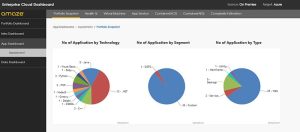This website uses cookies. By continuing to browse the site, you are agreeing to our use of cookies
Tackle your Cloud Modernization Pitfalls with Smart Cloud Adoption
Cloud
March 10, 2023
In today’s increasingly competitive landscape, the cloud has become indispensable for enabling a holistic digital transformation. Many businesses are turning to the cloud as their optimal solution to remain ahead of the competition and facilitate business agility, speedy innovation, and faster time-to-market. However, cloud migration is not a simple task that can be accomplished on the fly. It involves careful consideration of several factors and poses challenges that must be addressed meticulously. Successful cloud migration depends on aligning your business objectives with effective adoption strategies that incorporate all these factors.
While migrating to the cloud may be a quicker and more cost-effective way of eliminating on-premises systems, merely moving your workloads from on-premises to cloud environments will not yield the desired results. Challenges such as legacy application migration, containerization, or re-factoring have been roadblocks to a speedy cloud transformation. Additionally, the need to transform the backbone always has the potential to increase costs and drag out timelines.
One must ensure that their legacy applications and infrastructure are flexible, manageable, and resilient enough to evolve faster. This can be attained by adopting a right-fit cloud migration strategy or a cloud modernization approach that leverages the latest cloud technologies and embraces automation. The benefits of this approach include reduced total cost of ownership (TCO), increased business agility, high availability and fault tolerance, improved productivity, scalability, predictability, controllability, and so on. This may sound challenging initially, but having a free hand to make the necessary changes to your apps and infrastructure frequently (by adding new features or modules, optimizing performance, or enhancing security layers, among others) will allow for rapid growth within your organization.
To achieve optimal performance and cost-effectiveness in a cloud-based environment, enterprises should adopt automation-led cloud platforms that help drive their cloud transformation strategy. By finding the right platforms and yielding an outstanding speed of cloud transformation, enterprises can break through barriers that have hindered migrating legacy applications to the cloud. This will unleash the power of digital across the organization.
Our US-patented platform, amaze®, offers a suite of services and solutions focused on solving this challenge. Amaze® delivers with quality and speed via a product (rather than project) centric transformation approach, which is crucial in transforming your business. Amaze® cloud transformation services specialize in analyzing legacy monolith applications in only a few hours, providing recommendations for the transformation journey using automation, and executing the transformation toward all target architectures with maximum speed and significant TCO reduction.
To begin with, diligently conducting a cloud readiness assessment in line with your business vision makes it more likely that your cloud initiative will yield the expected business benefits.
Amaze® application portfolio assessment workbench is designed to tackle business hurdles and efficiently meet all your business demands. It bridges your current on-premises data center setup with the future cloud landscape. It helps you discover application complexities and anomalies in your IT environment to create a practical application cloud modernization roadmap. It analyzes a portfolio of application(s) and identifies app-level dependencies, assessing their readiness for transformation to the cloud. It then uses wave grouping based on deep code analysis, application dependencies, and inputs from app owners to suggest the right target “R” cloud treatment.
The application assessment phase is 100% automated, scanning the source code of each application to understand blockers, application health and complexity, functional dependencies and relevance, interfaces and data complexity, integration patterns, DevOps readiness, and so on. Doing so creates a detailed report with end-state architecture, potential APIs and microservices, right-sizing recommendations, and a modernization roadmap, among others. The report also details how it arrives at the numbers by going back deep into the lines of code.
Finally, the Cloud Readiness Index (CRI) is used to prepare actionable insights for deciding on a migration path and target platform. With maximized automation, amaze® can assess thousands of applications in days instead of months, saving time and cost while reducing manual efforts.
Fig 1: Amaze® Portfolio Assessment Dashboard

Fig 2: Portfolio Application(s) Assessment Details

In addition to the above capabilities, amaze® addresses many challenges with its in-built features. Some of these include:
- A cloud economic toolkit that can help you choose the optimum cloud transition strategy based on your business needs.
- The ability to modernize a complete IT portfolio to API-enabled microservices and migrate it to the cloud.
- The ability to cater to Lift and Shift (DC Exit), application + database modernization, and cloud migration.
- A service catalog of fine-grained migration/ modernization patterns with a robust security layer.
- Automation tools specifically built for some of the most common enterprise workloads.
- Supports PaaS, CaaS, and FaaS capabilities.
- Cloud-agnostic solutions offered across varied cloud models (public, private, and hybrid clouds) in line with the customers’ IT goals.
We help customers optimize their cloud costs by leveraging our IP amaze®, which enables them to identify the right design decisions and cloud factors to model. The amaze® platform provides enterprises with a 3-in-1 approach to leveraging the full benefits of a cloud environment. It helps them build resilience in their IT portfolios (infra, apps, and data), solve complex and critical business problems, and enable innovations. The platform catalyzes enterprise cloud transformation strategy by focusing on adaptable governance frameworks that can handle various implementation demands and risk profiles. This allows them to realize the actual cloud benefits effectively.
When enterprises understand cloud economics, they can optimize their investments and obtain the most excellent value for their organization. In addition to facilitating tremendous efficiencies and cost savings, cloud computing also enables another economic benefit: Business agility. Companies strategically utilizing cloud computing resources can deploy applications faster and ramp up storage and computing power on demand, allowing them to respond to market changes and customer demands more quickly. This IT agility leads to faster revenue growth.
To ensure a successful cloud journey, enterprises must choose a suitable platform, partner, and framework to help them accelerate cloud migration and modernization with zero chance of failure. This is where Hexaware’s comprehensive set of cloud services can assist them in revolutionizing their existing framework and achieving favorable business outcomes while ensuring world-class, end-to-end digital transformation.
About the Author

Srinivasan Panchapakesan
As a goal-driven visionary leader, Srinivasan has over 30 years of IT experience providing solutions across varied technologies. His expertise includes cloud, agile, DevOps, modern delivery, and solution architecture in domains including healthcare, insurance, life sciences, and banking & financial services. Srini leads and mentors the amaze® team globally to create solutions that add business value and enable the smooth adoption of cloud technologies. He is a passionate learner who drives employees to embrace new technology trends.
Read more
Related Blogs

Understanding Snowflake Cortex for Gen AI Applications with Sensitive Data
- Generative AI
- Cloud
- Data & Analytics

Ready to Pursue Opportunity?
Every outcome starts with a conversation
















